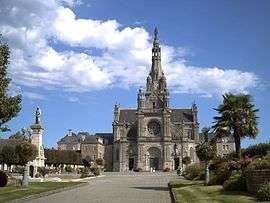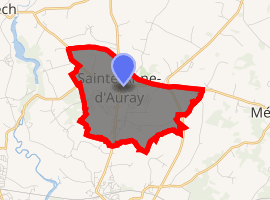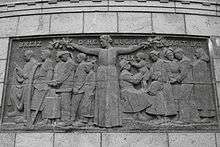Sainte-Anne-d'Auray
Sainte-Anne-d'Auray (Breton: Santez-Anna-Wened) is a commune in the Morbihan department of Brittany in north-western France. It is the third most popular pilgrimage site in France, after Lourdes and Lisieux.
Sainte-Anne-d'Auray Santez-Anna-Wened | |
|---|---|
 Basilique Sainte-Anne d'Auray | |
.svg.png) Coat of arms | |
Location of Sainte-Anne-d'Auray 
| |
 Sainte-Anne-d'Auray  Sainte-Anne-d'Auray | |
| Coordinates: 47°42′15″N 2°57′10″W | |
| Country | France |
| Region | Brittany |
| Department | Morbihan |
| Arrondissement | Lorient |
| Canton | Auray |
| Intercommunality | Pays d'Auray |
| Government | |
| • Mayor (2008—2014) | Roland Gastine |
| Area 1 | 4.97 km2 (1.92 sq mi) |
| Population (2017-01-01)[1] | 2,708 |
| • Density | 540/km2 (1,400/sq mi) |
| Time zone | UTC+01:00 (CET) |
| • Summer (DST) | UTC+02:00 (CEST) |
| INSEE/Postal code | 56263 /56400 |
| Elevation | 36–57 m (118–187 ft) |
| 1 French Land Register data, which excludes lakes, ponds, glaciers > 1 km2 (0.386 sq mi or 247 acres) and river estuaries. | |
History
Sainte-Anne-d'Auray is a village in the Diocese of Vannes (Morbihan), in Brittany, famous for its sanctuary and for its pilgrimages, or "pardons", in honour of St. Anne, to whom the people of Brittany, in very early times, on becoming Christian, had dedicated a chapel. This first chapel was destroyed about the end of the seventh century, but the memory of it was kept alive by tradition, and the hamlet was called "Keranna", i.e. "Village of Anne".[2]
More than nine centuries later, at the beginning of the seventeenth century (1624–25), St. Anne is said to have appeared several times to a simple and pious village farmer, and commanded him to rebuild the ancient chapel. The apparitions became so frequent, and before so many witnesses, that Sebastien de Rosmadec, Bishop of Vannes, deemed it his duty to inquire into the matter. Yves Nicolazic, to whom St. Anne had appeared, and numerous witnesses, testified to the truth of events which had become famous throughout Brittany, and around 1630 the Bishop gave permission for the building of a chapel. Anne of Austria and Louis XIII enriched the sanctuary with many gifts, among them a relic of St. Anne brought from Jerusalem in the thirteenth century, and in 1641 the Queen obtained from the Pope the erection of a confraternity, which Pius IX raised to the rank of an archconfraternity in 1872. In the meanwhile pilgrimages had begun and became more numerous year by year, nor did the Revolution put a stop to them. The chapel, indeed was plundered, the Carmelites who served it driven out, and the miraculous statue of St. Anne was burned at Vannes in 1793; yet the faithful still flocked to the chapel, which was covered with ex-votos.
In 1810 the convent of the Carmelites was turned into a petit séminaire. In 1866, the Cardinal Saint Marc laid and blessed the first stone of the present basilica. A new statute of Saint Anne was solemnly consecrated by order of Pius IX, 30 September 1868.[3] St. Anne has continued to be the favourite pilgrimage of Brittany down to the present day.[4] Pope John Paul II visited here in 1996. Every summer, there is the Grand Pardon of Sainte Anne, the largest pilgrimage in the region on July 26, the feast of St. Anne.[2] The religious services are followed by picnics, dancing and entertainment.
Basilica
The most notable feature of the village is the large Basilica of Sainte-Anne d'Auray, which is a major site of pilgrimage. Saint Anne is the patron saint of Brittany. The Basilica was built in Neo-Gothic style from 1865 to 1872 to replace an earlier church which had housed the ancient statue of Anne said to have been miraculously discovered by Yves Nicolazic.[3]
Nicolazic's house
Not far from the Basilica is the house where Yves Nicolazic and his family lived. The house was severely damaged in a fire in 1902, but restored five years later. A statue of St. Anne stands on the site of the barn, where the apparitions are said to have taken place.
Demographics
Inhabitants of Sainte-Anne-d'Auray are called in French Saintannois.
Breton language
In 2008, 10,82% of all children in the area attended bilingual schools in primary education.[5]
Gallery
 Basilica
Basilica memorial to Breton victims of World War I
memorial to Breton victims of World War I Le voeu à Sainte-anne-d'Auray by William-Adolphe Bouguereau
Le voeu à Sainte-anne-d'Auray by William-Adolphe Bouguereau
See also
References
- "Populations légales 2017". INSEE. Retrieved 6 January 2020.
- "Grand Pardon de Sainte-Anne", Tourist Board of Morbihan
- Goyau, Georges. "Diocese of Vannes." The Catholic Encyclopedia Vol. 15. New York: Robert Appleton Company, 1912. 20 July 2019

- Fournet, Pierre Auguste. "Sainte Anne d'Auray." The Catholic Encyclopedia Vol. 1. New York: Robert Appleton Company, 1907. 19 Jul. 2019

- (in French) Ofis ar Brezhoneg: Enseignement bilingue
![]()
External links
| Wikimedia Commons has media related to Sainte-Anne-d'Auray. |
- Sanctuaire de Sainte-Anne d'Auray
- French Ministry of Culture list for Sainte-Anne-d'Auray (in French)
- "The symbolism of a French officer’s sacrifice", Herald Courier, March 31, 2018
- Herbermann, Charles, ed. (1913). . Catholic Encyclopedia. New York: Robert Appleton Company.